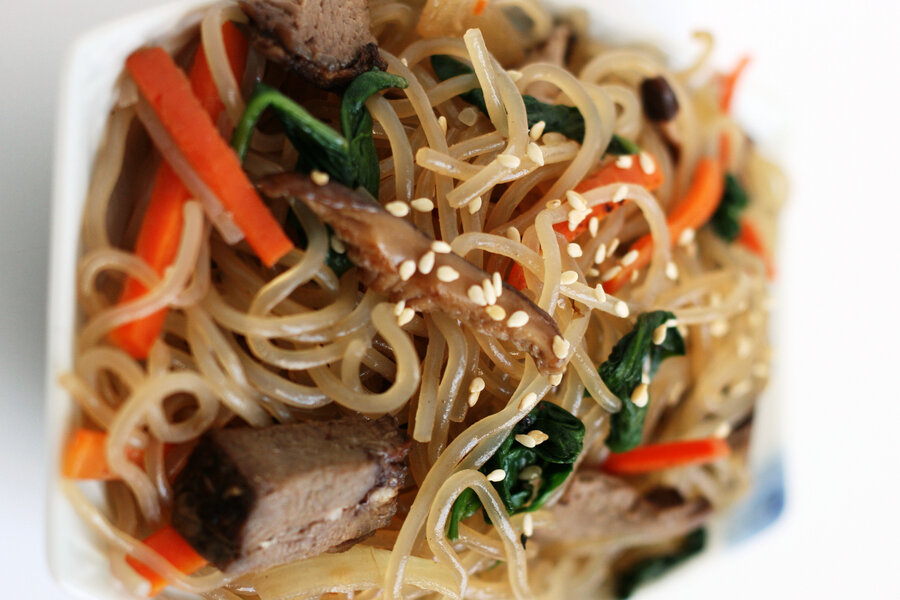Korean stir-fried glass noodles, 'japchae'
Loading...
I heart noodles. Ramen. Chow mein. Pancit. And especially my mom’s mie goreng (Indonesian fried noodles). But today, I’d like to give a shout-out to a lesser known noodle dish – japchae.
A classic Korean dish, you’ll find japchae on the menu at just about any Korean restaurant in the U.S. If you’re lucky enough to be invited to a party at a Korean friend’s house, japchae will probably show up on your plate, together with kalbi and kimchi.
Like many other Asian noodle dishes, japchae is a stir-fried mix of noodles, vegetables, and meat. It happens to use an unusual type of noodle made from sweet potato starch, which seems to be unique to Korean cuisine. Koreans have already shown their ingenuity by mixing rice with other grains to make supplies go further – et voilà, jabgok-bap (mixed grain rice), so perhaps they invented sweet potato starch noodles when wheat was unavailable.
Clear and chewy, sweet potato noodles are a fabulous blank canvas for soaking up the sweet and savory flavors of soy sauce, sugar and sesame oil. These pale gray strands are also the reason why japchae is commonly known as glass noodles. Plus, japchae has mass appeal: It’s popular for feeding a crowd because it’s easy to make in bulk and is tasty both warm or at room temperature – perfect for a buffet or a picnic.
Noodles – signifying long life – are a must during birthdays and the new year.
Stir-fried glass nboodles (Japchae)
Makes 6-8 servings
Japchae is often a co-mingling of noodles and an assortment of vegetables and meat. My recipe uses only vegetables but feel free to add your choice of protein. I’ve sliced up leftover sirloin steak, and barbecued pork (about 1 cup) and tossed them in with the noodles. Sweet potato noodles are sold at Asian markets. If you can’t find them, substitute the fattest mung bean/cellophane noodles available and follow the package directions to cook.
1 pound dried Korean sweet potato noodles
Hot water
8 ounces spinach, trimmed (4 to 5 cups)
2 tablespoons vegetable oil, plus more as needed
6 medium dried black mushrooms, rehydrated and cut into thin slices (3/4 cup)
1 small yellow onion, halved and cut into thin crescents
2 medium carrots, peeled and cut into matchsticks (1-1/4 cups)
3 green onions, white and green parts, cut into 1-inch lengths
2 cloves garlic, minced
1⁄3 cup soy sauce
3 tablespoons brown sugar
1 tablespoon sesame oil
1 tablespoon toasted sesame seeds
1. Place the noodles in a heatproof bowl and soak in hot water for 15 minutes.
2. With kitchen shears, cut into 3- to 4-inch pieces. You just want the noodles to be manageable so don’t worry about getting exact lengths. Drain and set aside.
3. Place the spinach in a heatproof bowl and soak in very hot water for 1 to 2 minutes until wilted but not fully cooked. Rinse under cold running water and drain. Gently squeeze the water from the spinach and cut into 3 sections.
4. Preheat a large wok or skillet over medium-high heat for 1 minute. Swirl in the oil and heat until it becomes runny and starts to shimmer. Add the mushrooms, onion, carrots, green onions, and garlic and stir and cook until the carrots are crisp tender, 2 to 3 minutes. Reduce the heat to medium and toss in the noodles (here’s where you add precooked meat if you’d like).
5. Add the soy sauce, brown sugar, and sesame oil. Stir everything swiftly around the wok for 3 to 4 minutes, coating the noodles evenly with the seasonings. Add more oil if the noodles stick to the bottom of the wok. Taste and adjust seasonings if desired.
6. Mix in the spinach and sesame seeds at the very end and toss with a couple more flourishes. Serve hot or let cool to room temperature.
Note: Japchae keeps well and can stay fresh for up to a week in the refrigerator. To reheat, cook in a skillet and add sesame oil until the noodles are supple and heated through.
Related post on Pickles and Tea: Indonesian-Style Chicken-Mushroom Noodles








